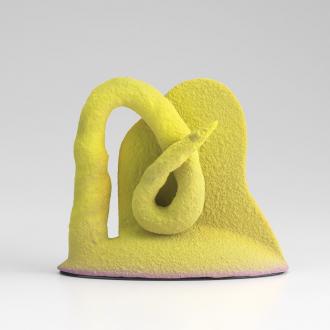The traditions of art museum display persist for a reason. Lining objects all in a row, hung on walls or mounted on pedestals, allows the viewer, in a way that reminds me of college essay assignments, to compare and contrast. Keeping one more or less uniform background across an exhibition of disparate works can also show off the uniqueness of each piece.
But the ostensibly neutral setting of the traditional gallery layout is also a kind of sensual and intellectual tyranny. At its most extreme, a show laid out in strict sequence around one rectangular room leaves the viewer little choice, and limited opportunity for discovery.
“Ron Nagle: Handsome Drifter,” on view at UC Berkeley Art Museum and Pacific Film Archive through June 14, presents a retrospective selection of work by the beloved Bay Area sculptor of the magically minute. It consists of 27 heartbreakingly lovely ceramic objects, each of them monumental in every sense but their physical size, which rarely exceeds 5 inches in any dimension. The show is augmented by 17 seemingly effortless preparatory drawings on letter-size sheets.
The sculptures are presented in identical small vitrines set at regular intervals in two walls of the room, and atop a continuous, U-shaped pedestal in the center of the room. It’s a layout the artist seems to prefer — other shows have looked similar — but it does the art a disservice. Some might call the design minimalist; I would say airless.
It may not be entirely fair, but the show puts me in mind of other recent museum exhibitions that had much the same problem. It may be a particular affliction of ceramic exhibitions, which start out with small objects that seem to want to be lined up on shelves.
What if, instead of emphasizing similarities of form and material, such works were shown in a way that heightened the drama of each individually? Where a wandering path among them led to surprises around each corner? Where some pieces had whole rooms of their own?
What if some small ceramic sculpture were shown on a turntable with chairs or benches set about, so that viewers might see the works as their makers saw them — from above, then eye level? From subtly various, minutely shifting points of view? What if certain works, closely guarded as necessary, were shown outside those distracting protective boxes that can’t help but become an unplanned, unwanted part of the art?
What if the Nagle exhibition truly exposed his scatology of art in clay?
Most of Nagle’s signature moves are discernible even as they are presented in the BAMPFA show. One can move one’s head from side to side, up and down to gain various perspectives.
Make the effort.
“Night of the Hunter” (1998), its evocative title borrowed from classic film noir, reveals a glassy sliver of pure, passionate red, peeking from below the edge of a pebbled surface, dusty with what must be the surreal hues of poisoned deserts on undiscovered planets.
Animal- and plant-like forms, like the cactus-y comic figure in “Drab Leg Buffet” (2008), stand and lie in varied states of suspended animation. Alien. Gnarled. Modeled, in one case, on the excrement of a dog. And transcendent, still, because it is so authentically observed and reimagined.
The artist’s top-banana humor comes though loud and clear in titles like “Whole Lotta Palapa,” “Beirut Canal” and “Karma Gouda.” But it’s the visual wallop of a pumped-up, busty pair of cerulean orbs floating on a bed of sherbet pink, lewdly launching a hot-tipped cylinder, that might make one laugh out loud. Its name, appropriately, is “The Bad Clown.”
Nagle was born in San Francisco, where he lives today. He will turn 81 during the run of the show. He is a credible pop music composer and performer. All this, you can learn from the exhibition catalog, which contains the requisite words of introduction and acknowledgement, a biographically revealing interview and chronology, a thorough bibliography and good reproductions of photographs.
To see the art, however, you will have to visit the museum in Berkeley. The best visual art renders description superfluous at best, misleading all too often. There is no adequate substitute for the original.
Even if you must view it in rows of glass-front boxes.
“Ron Nagle: Handsome Drifter”: 11 a.m.-7 p.m., Wednesdays-Sundays. Through June 14. $12-$14; free for ages 18 and under, and for one adult per child 13 & under. UC Berkeley Art Museum and Pacific Film Archive. 2155 Center St., Berkeley. 510-642-0808. https://bampfa.org
